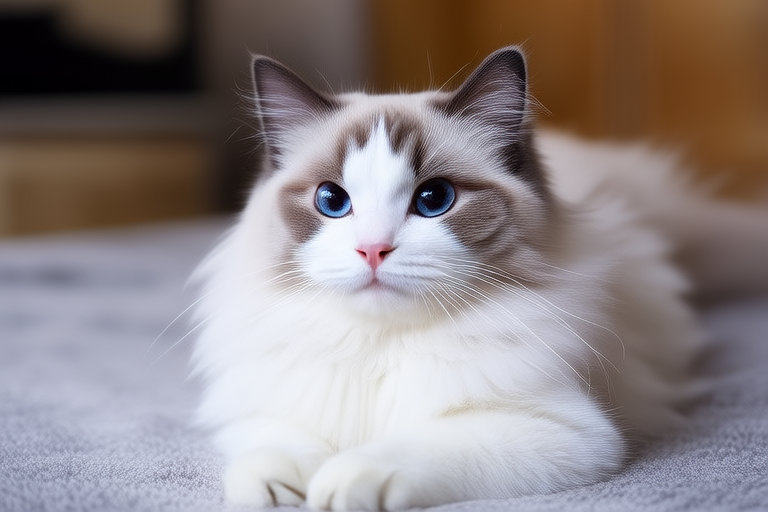Top 7 Fascinating Facts About Ragdoll Cats You Didn’t Know
Ragdoll cats have long been admired for their stunning appearance and gentle demeanor. These large, semi-longhaired felines have captured the hearts of many cat lovers worldwide. However, there are several intriguing aspects about Ragdolls that might surprise even the most seasoned cat enthusiast. In this article, we will explore seven fascinating facts about Ragdoll cats, shedding light on their temperament, physical characteristics, history, and some lesser-known traits.
1. The Origin of the Ragdoll Name
The name ‘Ragdoll’ comes from the breed’s tendency to go limp when picked up, similar to a rag doll. This characteristic is due to their naturally relaxed nature and calm disposition. When held, these cats often relax completely, making them incredibly comfortable companions. This unique trait was first observed by Ann Baker, the breeder who developed the Ragdoll breed in the 1960s. She noted that her cats would become so relaxed when picked up that they would hang like a rag doll in her arms.
2. Hypnotic Blue Eyes
Ragdoll cats are known for their striking blue eyes, which are a hallmark of the breed. The intense blue color of their eyes is caused by a high concentration of pigment in the iris. This eye color is linked to the breed’s point coloration, a genetic trait that causes darker colors on the extremities (ears, face, paws, and tail) while leaving the body lighter. The contrast between the deep blue eyes and the lighter coat makes Ragdolls stand out among other breeds.
3. A Gentle Giant Among Cats
Ragdolls are considered one of the largest domestic cat breeds, with males weighing between 12 to 20 pounds and females ranging from 8 to 15 pounds. Despite their size, Ragdolls are known for their docile and affectionate nature. They are often described as being dog-like in their behavior, following their owners around the house and even learning to fetch toys. Their gentle temperament makes them ideal companions for families with children and other pets.
4. The History of the Ragdoll Breed
The Ragdoll breed has a relatively short history, having been developed in the 1960s by Ann Baker in Riverside, California. Baker crossbred a seal-point Persian female with a bi-color male cat, resulting in the first Ragdoll kittens. Over time, she selectively bred these cats to enhance their unique characteristics, such as their semi-longhair coats, blue eyes, and laid-back personalities. Today, Ragdolls are recognized by major cat registries, including the Cat Fanciers’ Association (CFA).
5. Hypoallergenic Myth
Despite popular belief, Ragdoll cats are not hypoallergenic. However, they may be a better option for people with cat allergies compared to other breeds. This is because Ragdolls produce less of the Fel d 1 protein, which is responsible for causing allergic reactions in humans. Additionally, their semi-longhair coats require regular grooming, which can help reduce the amount of dander in the environment. For those with mild allergies, a Ragdoll might be a suitable choice, but it’s always advisable to spend time with the cat before committing to adoption.
6. Intelligence and Trainability
Ragdolls are highly intelligent and trainable cats, capable of learning tricks and commands. They can be taught to walk on a leash, play fetch, and even use a litter box on command. Their intelligence combined with their docile nature makes them easy to train, and they often enjoy participating in activities with their owners. This trainability also extends to their ability to learn household routines, making them excellent companions for busy households.
7. Health and Longevity
Ragdolls are generally healthy cats with a lifespan of 12 to 15 years. However, like all purebred cats, they are prone to certain genetic health issues. One of the most common conditions affecting Ragdolls is hypertrophic cardiomyopathy (HCM), a form of heart disease that can lead to sudden death if left untreated. Regular veterinary check-ups and early intervention can help manage this condition. Another issue is obesity, which can be prevented through proper diet and exercise. Maintaining a healthy weight is crucial for extending a Ragdoll’s lifespan and ensuring their overall well-being.
Conclusion
Ragdoll cats are truly unique creatures, combining beauty with an exceptional temperament. From their hypnotic blue eyes to their gentle giant demeanor, these cats offer much more than just companionship. Whether you’re a seasoned cat owner or considering adopting your first feline friend, the Ragdoll breed is worth exploring. With their intelligence, trainability, and affectionate nature, Ragdolls make wonderful additions to any home. By understanding these fascinating facts, you’ll gain a deeper appreciation for the remarkable qualities that make Ragdolls stand out among other cat breeds.
